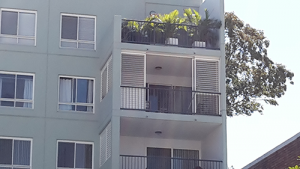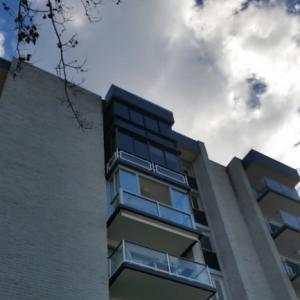Balcony Enclosure Safety & Code Compliance
Shutters or blinds, window enclosures or panel walls installed to completed buildings may impinge upon building occupant safety
Background
In the wake of London’s Grenfell Tower fire tragedy and Melbourne’s Lacrosse Tower, combustible cladding has been identified as a major safety concern for occupants of multi-storey apartment buildings.
The Queensland Building and Construction Commission (QBCC) is at the forefront of the Queensland Government’s effort to ensure building occupant safety is maintained and improved on all private and public buildings.
The QBCC has become aware of an increasing trend to install external shutters or blinds, glazed window enclosures or panel walls to balconies of multi-residential high-rise apartment buildings following practical completion and hand over.
 A shutter installation on previously open balcony
A shutter installation on previously open balcony
While there are some benefits associated with the installation of these items for example increased privacy and shade and weather resistance, there are potentially negative impacts that may arise. Installing external shutters or blinds, glazed windows or panel wall enclosures on balconies of high rise apartments may impede the building’s fire safety and resistance.
All buildings go through a rigorous assessment process by a building certifier at the building development approval stage to ensure compliance with the Building Code of Australia (BCA). To comply with the BCA, buildings are assessed against performance requirements relevant to things such as structure, fire resistance, access and egress, health and amenity, and energy efficiency.
The retro-fitting of external shutter and blind systems, glazed window enclosures or panel walls post construction, which have not been assessed through a building development approval process, could impinge on the building’s performance in several important areas including:
Fire Safety
Items such as shutters and blinds may not be made entirely of non-combustible materials and installing these may promote the spread of fire across the external facade of a building and contribute to unacceptable levels of smoke.
Commonly, on multi-storey apartment projects, building designers apply a concept known as “vertical separation”. This limits the spread of fire from one storey to another by utilising the non-combustible properties of concrete. Concrete balcony floor slabs, above one another, act as a barrier to the spread of fire on the outside face of a building.
When an item such as an external shutter or blind, glazed window enclosure or panel wall are added to a building, it may effectively provide a physical bridge between previously separated storeys. If it is manufactured to include combustible material, it will almost certainly promote the spread of fire up the external face of the building.
There are also risks associated with installing items such as shutters and blinds directly above fire exits in any building, if they contain any combustible material.
Falling and flaming debris could render a fire exit unusable in a fire and impede egress from a building. In turn, this may cause an additional hazard to emergency services personnel.
Light and Ventilation
Natural light and natural ventilation is normally required to all habitable rooms in a building. The minimum levels required under the BCA may be impacted by the installation of an external shutter or blind system.
 Glazed window enclosures retrofitted to balconies
Glazed window enclosures retrofitted to balconies
Structural Provisions
Items such as blinds and awnings, glazed window enclosures or panel walls incorporated into the exterior of any building are subjected to wind loads. These loads, particularly on a multi-storey apartment building, may be significant and exceed the loads normally experienced at ground level.
The determination of such wind loads on a multi-storey building is a complex task and falls within the professional expertise of a structural engineer to assess. The assessment will include not only potential wind loads, but the suitability of the fixings proposed to be used to secure these items to a building.
The importance of ensuring anything added to the outside of a building is properly engineer designed is paramount. This was highlighted by an incident that occurred in 2009 on the Gold Coast where a person was killed after being hit by a dislodged balcony privacy screen during a severe storm.
Aesthetics
Large multi-story apartment buildings would most likely have been the subject of a Planning Approval which ensures, amongst other things, the aesthetics of a building comply with the local authority planning scheme.
The retro-fitting of external shutters and blinds, glazed window enclosures or panel walls may breach the planning requirements and trigger enforcement action by local governments if complaints were received from disgruntled community members or adjoining apartment owners.
Building Assessment
In Queensland additions to a completed building such as the installation of external shutters or blinds, glazed window enclosures or panel walls are captured under the definition of “building work” for the purposes of the Building Act 1975 and must comply with the BCA.
The enclosing of a balcony with shutters or blinds, glazed window enclosures or panel walls would trigger the requirement for a building development approval and may trigger planning development approval under the relevant planning instrument.
A common misconception by unit owners and contractors installing these products is that approval by a building’s Body Corporate is akin to building approval and all that is required, this misconception needs to be dispelled.
Unless contractors who install external shutters and blinds, window enclosures or panel walls are skilled in understanding and interpreting requirements of the BCA, they may be unwittingly impinging upon the levels of fire safety afforded to occupants of a completed building. They may also be caught up in protracted litigation if an incident were to arise in the future.
Recommendation
QBCC’s message to individual apartment owners and their responsible Body Corporates is that the retro-fitting of items, such as external shutters and blinds, glazed window enclosures or panel walls should be considered best practice only when done in consultation with a building certifier.
Building certifiers conduct a thorough assessment process to ensure that building occupant and public safety is not compromised by the installation of such items.
Need more information? Visit www.qbcc.qld.gov.au or call QBCC on 139 333.
This article was released by the Queensland Building and Construction Commission.


Leave a Reply
Unit owner wants to install window to outside balcony.
Our by law says that this cannot be done
Reason noise.
Is there legislation in place that after a certain year that balconies could not be enclosed.
Hi Roslyn,
Appreciate if you could let me know what happened with the work and how did the BC handle this and the outcome. AS we are facing the same situation in our building.
Cheers!
We have an owner who wishes to fully enclose his balcony with shutters. His 3rd storiey apartment has only the 1 balcony and 1 entry door on the other side of the unit which leads to a common area which has the lift and fire door to the stairwell. The CoO is concerned about the fire risk and access for the Fire and Emergency personnel in the event of fire.. The balconies in our complex contain BBQ’s, some gas heaters, fridges,coushes and floor rugs along with the exhaust fan from our 2.5kw air conditioning units, all a fire risk. Can somebody please send me any information regulations on this matter relavent to WA? Much Appreciated. Pedro Dunn
I have to say this advice reads extremely negatively (it seems to be saying how to say no on so many levels) and does not take into account poor design that has led to people wanting to spend additional money to improve the livability of their apartments. A good example is numerous apartments have west facing balconies that become almost unusable in the late afternoon-early evening. If the developer or even the approving authority had factored this in the first place, there may be less demand for retrofitting shade solutions.
With the possible impacts of climate change, this is likely to be an enduring issue.
I live in a unit, whereby I wish to install a blind or shutter ,to block out the incredible heat and reflection from the roof top of a restaurant, that is directly in front and adjoining to my unit balcony..The restaurant below me has a blind and I have had quotes measurements etc from the same company, however my request has been denied and I am waiting on a valid legal reason from the body Corp .
I have ascertained that material used as per restaurant below myself are all within fire regulations.
I enjoy sitting on my balcony and having had many skin grafts flaps etc for skin cancer it is upmost important that I protect myself from more damage.
I believe that umbrellas are unsightly and dangerous on a balcony .
The blind would only be utilised when needed as per the restaurant below my unit .
I am not looking to enclose my balcony but merely to make it comfortable when sitting outside
Even my cushion covers are melting from the heat of the balcony.
It would be electric like the restaurant below my unit which is part of the same building.
Hi Jayne I’m in the same position with a west facing balcony my strata said yes but manufacturer of the blind said we need a fire engineer certificate.
Did you ever receive a response to your question above